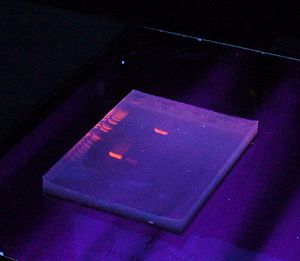Gel electrophoresis facts for kids

Gel electrophoresis is a cool science trick. It helps scientists sort tiny pieces of things like DNA and proteins. It sorts them by their size and how much electric charge they have. Imagine a jelly-like substance, called a gel (like gelatin you eat!). Scientists put an electric field through this gel. The name "electrophoresis" comes from "electro" (for electricity) and "phoresis" (meaning movement). So, it's about moving things with electricity!
Contents
What is the Gel Made Of?
The gel is made of long, tangled chains called polymers. Think of it like a dense spaghetti network. How tangled these chains are decides how easily molecules can wiggle through.
If the gel is very tangled, small molecules can move through easily. But big molecules will move very slowly or might not move at all. If the gel is less tangled, both big and small molecules can move more easily.
How Molecules Move in the Gel

Molecules move in the gel because of their electric charge. If a molecule has a strong charge, it will be pulled strongly towards the opposite electric side of the gel. But if it's a big molecule, it will have a hard time squeezing through the gel's tangled network. So, bigger molecules usually move slower.
Small charged molecules can zip through the gel much faster. They get through the tiny holes in the gel more easily. This sorting by size is like using a sieve, where smaller things fall through faster. If a molecule has no electric charge, it won't move at all.
Seeing the Results
After the electric field has been on for a while, you need to see where the molecules have moved. Scientists add special stains to the gel. These stains make the molecules show up as colored lines or "bands."
Some stains, like Coomassie blue for proteins, can be seen with your eyes. Other stains, like those for DNA (like ethidium bromide), need a special ultraviolet lamp to be seen.
How Gel Electrophoresis is Used
Sorting DNA Pieces
Gel electrophoresis is a very common way to study DNA. DNA is a huge molecule that holds all our genetic information. Scientists can break DNA into smaller pieces of different sizes. Then, they use gel electrophoresis to sort these pieces. DNA always has a negative charge, so it always moves towards the positive end of the gel.
Studying Proteins
Proteins are big, complex molecules made of smaller parts called amino acids. Gel electrophoresis can be used to study proteins in two main ways. Scientists can separate a mixture of different proteins. Or, they can break one protein into smaller pieces and then separate those pieces.
Proteins can have either a positive or a negative charge. To sort proteins only by their size, scientists can add a chemical called sodium dodecyl sulfate (SDS). This chemical coats all the proteins and gives them a negative charge. Then, they will all move towards the positive end of the gel, and their speed will mostly depend on their size.
Uses in Medicine
In medicine, there's a special type of electrophoresis called iontophoresis. This method uses the same idea of moving things with electricity. It helps deliver medicines into the human body through the skin. This means patients can get medicine without needing a needle!
Images for kids
-
This gel shows the results of a PCR test. The lines show DNA pieces, compared to a DNA "ladder" that has known sizes.
See also
 In Spanish: Electroforesis en gel para niños
In Spanish: Electroforesis en gel para niños






